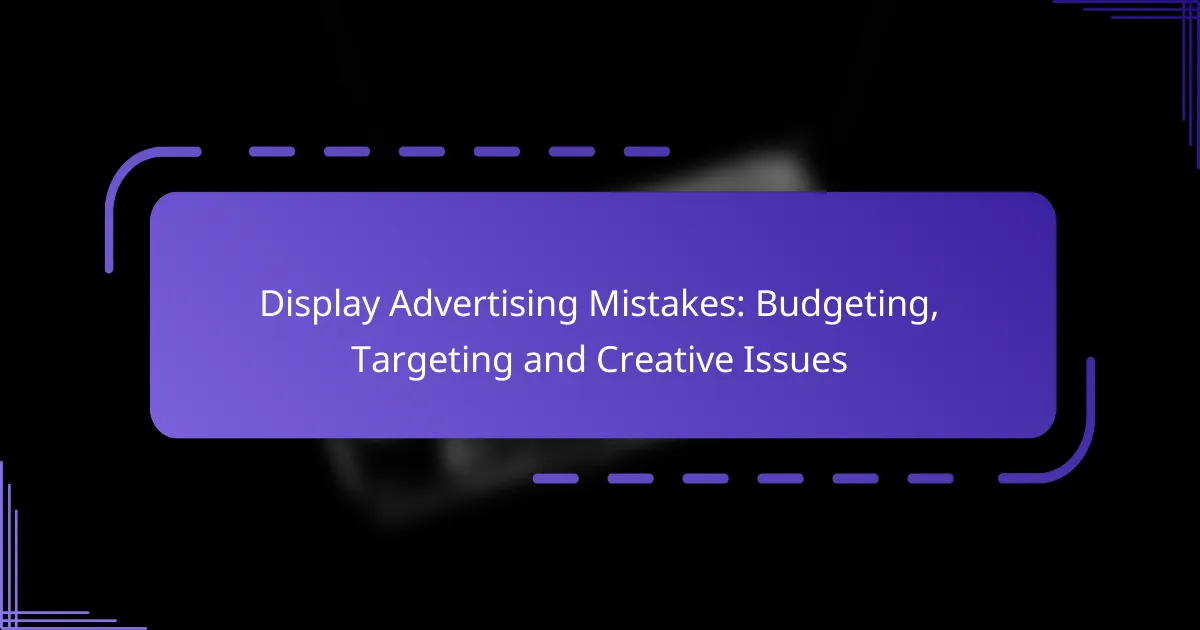Display advertising can be a powerful tool for reaching your audience, but common mistakes in budgeting, targeting, and creative execution can undermine its effectiveness. Miscalculating campaign costs, neglecting to allocate funds for testing, and targeting the wrong audience can lead to wasted resources and missed opportunities. By addressing these pitfalls, advertisers can enhance their campaigns and achieve a better return on investment.

What are common budgeting mistakes in display advertising?
Common budgeting mistakes in display advertising include miscalculating total campaign costs, failing to set aside funds for testing, and not adjusting budgets for seasonal fluctuations. Addressing these issues can significantly enhance campaign effectiveness and return on investment.
Underestimating total campaign costs
Many advertisers underestimate the total costs associated with display advertising, which can lead to budget shortfalls. This includes not only the cost of ad placements but also expenses related to creative development, technology fees, and potential agency costs.
To avoid this pitfall, create a comprehensive budget that accounts for all aspects of the campaign. A good rule of thumb is to add a buffer of 10-20% to your estimated costs to accommodate unexpected expenses.
Neglecting to allocate for testing
Failing to allocate a portion of the budget for testing can hinder campaign optimization. Testing different ad creatives, placements, and targeting strategies is crucial for understanding what resonates with your audience.
Set aside at least 15-20% of your total budget for A/B testing and experimentation. This investment can lead to improved performance and greater overall effectiveness in your advertising efforts.
Ignoring seasonal budget adjustments
Seasonal trends can significantly impact the effectiveness of display advertising, yet many advertisers overlook the need to adjust their budgets accordingly. Certain times of the year, such as holidays or back-to-school seasons, may require increased spending to capitalize on heightened consumer interest.
Regularly review historical performance data to identify peak periods for your industry. Adjust your budget to allocate more resources during these high-demand times, ensuring you maximize visibility and engagement when it matters most.

How can you optimize your display advertising budget?
To optimize your display advertising budget, focus on strategic allocation of funds based on performance metrics and audience targeting. This involves regularly analyzing campaign results and adjusting spending to maximize return on investment.
Implementing cost-per-click strategies
Cost-per-click (CPC) strategies allow advertisers to pay only when users engage with their ads. This model encourages efficient spending, as you can set maximum bids based on the value of conversions. Start by determining your target CPC based on your overall budget and desired outcomes.
Consider segmenting your campaigns by audience or ad placement to identify which segments yield the highest returns. Regularly monitor performance and adjust bids to ensure you are not overspending on low-performing ads.
Utilizing budget forecasting tools
Budget forecasting tools help predict future spending and revenue based on historical data. These tools can provide insights into seasonal trends and performance fluctuations, allowing for better financial planning. Look for tools that integrate with your advertising platforms for real-time updates.
When using forecasting tools, consider factors such as market changes, competitor activity, and economic conditions. Regularly review and adjust your forecasts to reflect any shifts in your advertising landscape, ensuring your budget remains aligned with your business goals.

What targeting issues affect display advertising performance?
Targeting issues can significantly hinder the effectiveness of display advertising by reaching the wrong audience or failing to engage potential customers. Understanding these issues is crucial for optimizing ad spend and improving campaign outcomes.
Overly broad audience targeting
Overly broad audience targeting can dilute your advertising efforts, leading to wasted budget on users who are unlikely to convert. Instead of casting a wide net, focus on specific segments that align closely with your product or service.
Utilize tools that allow for granular targeting based on interests, behaviors, and online activities. For example, targeting users who have shown interest in similar products can yield better engagement rates and conversion potential.
Failure to use retargeting effectively
Failing to implement retargeting strategies can result in missed opportunities to convert interested users. Retargeting allows you to reach individuals who have previously interacted with your brand, reminding them of your offerings.
Consider segmenting your retargeting audience based on their previous interactions, such as website visits or abandoned carts. This tailored approach can increase the likelihood of conversion by delivering relevant ads to users who have already expressed interest.
Neglecting demographic analysis
Neglecting demographic analysis can lead to misaligned advertising efforts that fail to resonate with your target audience. Understanding the age, gender, income level, and location of your potential customers is essential for crafting effective ads.
Use demographic data to refine your targeting strategy. For instance, if your product appeals primarily to young adults, focus your ads on platforms and channels where this demographic is most active. Regularly review and adjust your targeting based on demographic insights to enhance campaign performance.

How can you improve targeting in display advertising?
Improving targeting in display advertising involves using data-driven strategies to reach the right audience effectively. By leveraging analytics and audience insights, advertisers can enhance their campaigns and increase return on investment.
Leveraging data analytics platforms
Data analytics platforms provide valuable insights into user behavior, preferences, and demographics. By analyzing this data, advertisers can identify trends and patterns that inform their targeting strategies. For example, platforms like Google Analytics or Adobe Analytics can help track user interactions and optimize ad placements based on performance metrics.
To effectively leverage these platforms, regularly review key performance indicators (KPIs) such as click-through rates (CTR) and conversion rates. This will allow you to adjust your targeting parameters and allocate budget more efficiently. Avoid relying solely on historical data; instead, incorporate real-time analytics to stay responsive to market changes.
Utilizing lookalike audiences
Lookalike audiences allow advertisers to target new users who share similar characteristics with their existing customers. This method expands reach while maintaining relevance, as these potential customers are more likely to engage with your ads. Platforms like Facebook and Google Ads offer tools to create lookalike audiences based on your current customer data.
When utilizing lookalike audiences, ensure that your source audience is well-defined and representative of your ideal customer. Aim for a balance between audience size and similarity; a larger audience may dilute targeting effectiveness. Regularly refresh your lookalike audience to incorporate new data and adapt to changing consumer behaviors.

What creative issues hinder display advertising success?
Creative issues can significantly impact the effectiveness of display advertising by reducing engagement and conversion rates. Key problems include poor design, inconsistent branding, and a lack of mobile optimization.
Poor ad design and messaging
Poor ad design and messaging can lead to low click-through rates and wasted budget. Ads should be visually appealing and convey a clear message that resonates with the target audience. Using high-quality images, readable fonts, and concise text can enhance the overall effectiveness of the ad.
Consider A/B testing different designs to identify what works best. For example, a simple, bold call-to-action can outperform a cluttered ad with excessive text. Aim for a balance between creativity and clarity to capture attention quickly.
Inconsistent branding across ads
Inconsistent branding can confuse potential customers and weaken brand recognition. All display ads should maintain a uniform look and feel, including colors, logos, and messaging. This consistency helps reinforce brand identity and builds trust with the audience.
To ensure branding consistency, create a style guide that outlines design elements and messaging strategies. Regularly review ads across different platforms to confirm they align with the established brand identity.
Failure to optimize for mobile devices
With a significant portion of web traffic coming from mobile devices, failing to optimize ads for mobile can result in lost opportunities. Ads must be responsive and visually appealing on smaller screens, ensuring that text is legible and images are clear.
Utilize mobile-friendly formats, such as vertical ads or adaptive designs, to enhance user experience. Test ads on various devices to ensure they display correctly and maintain functionality, such as clickable links or buttons. Prioritize mobile optimization to reach a broader audience effectively.

How can you enhance creative effectiveness in display ads?
Enhancing creative effectiveness in display ads involves optimizing visuals, messaging, and formats to engage your target audience. Key strategies include understanding audience preferences, utilizing A/B testing, and ensuring consistency across campaigns.
Conducting A/B testing for creatives
A/B testing for creatives allows advertisers to compare two or more versions of an ad to determine which performs better. By changing elements like headlines, images, or calls to action, you can identify what resonates most with your audience.
When conducting A/B tests, it’s essential to isolate one variable at a time to accurately measure its impact. For example, if you change both the image and the headline, you won’t know which change drove performance. Aim for a sample size that provides statistically significant results, typically in the hundreds or thousands, depending on your overall traffic.
Common pitfalls include running tests for too short a duration or failing to track key performance indicators (KPIs) like click-through rates (CTR) and conversion rates. Always analyze the data thoroughly and apply the insights to future campaigns to continuously improve your creative effectiveness.
